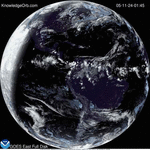
Temperature in 2012 compared to the 1981-2010 average. Credit: NOAA Climate.gov, based on NCDC data.
According to a report released by NOAA 2012 global surface temperature was among the 10 warmest ever recorded. This is alarming as there is no sign of the trend stopping, or better yet reversing. CO2 levels, which are also alarmingly high, are part of the now almost undisputed man-made cause of this change to our planet. Major greenhouse gas concentrations, including carbon dioxide, methane, and nitrous oxide, continued to rise during 2012. Following a slight decline in man-made emissions associated with the global economic downturn, global CO2 emissions from fossil fuel combustion and cement production reached a record high.
Conditions in 2012
Over land and ocean combined, 2012 was between 0.14° and 0.17° Celsius (0.25°and 0.31° Fahrenheit) above the 1981–2010 average, depending on the analysis. The globally averaged annual temperature over land was 0.24°–0.29°C (0.43°-0.52°F) above average. And averaged globally, the 2012 ocean temperature was 0.10°–0.14°C (0.18°-0.25°F) above average.

Earth’s average annual surface temperature is higher today than it was when record keeping began more than a century ago. The red line shows how far above or below the 1981–2010 average (dashed line at zero) the combined land and ocean temperature has been each year since 1880. The data shown are from NOAA’s National Climatic Data Center, one of several temperature analyses included in the State of the Climate in 2012, all of which show a similar warming trend. Graph adapted from Figure 2.1, in BAMS State of the Climate in 2012.
In the Arctic the last 50 years were nearly free of summer ice. the region experiencing unprecedented change breaking several records. Sea ice shrank to its smallest “summer minimum” extent since satellite records began 34 years ago. In addition, more than 97 percent of the Greenland ice sheet showed some form of melt during the summer, four times greater than the 1981–2010 average melt extent.
Some of the effects we see include the intensifying of global rainfall, rise in global sea levels, changes in northern seasons, and even a future reduction in the workforce. Al Gore made a film called “An Inconvenient Truth” which outlines some of the issues including a direct correlation with CO2 levels and the rise in Earth’s temperature. If you have not seen this documentary it is a real eye opener.
The 2012 State of the Climate report is peer-reviewed and published annually as a special supplement to the Bulletin of the American Meteorological Society. This year marks the 23rd edition of the report, which is part of the suite of climate services NOAA provides to government, the business sector, academia, and the public to support informed decision-making. The full report can be viewed online.







